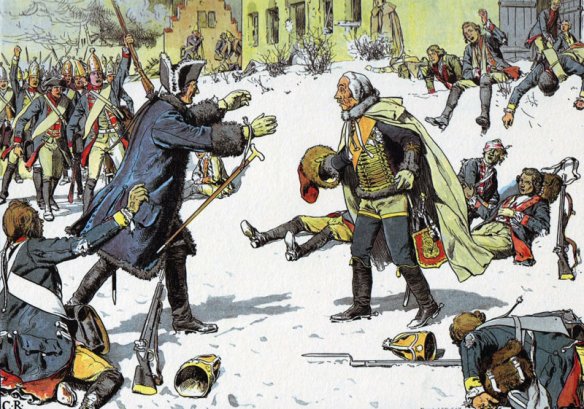Frederick the Great greets General Zieten after the Battle of Torgau.
The fighting began in Silesia when an Austrian corps under General Loudon defeated a Prussian corps at Landeshut on 23 June 1760. The Austrians heavily outnumbered the Prussians, 34,000 men to 11,000. The Prussians were easily defeated, losing 10,000 men killed and captured. The Austrians then moved with two corps to destroy the main Prussian army. Field Marshal Daun and General Loudon marched and met, combining their forces near the village of Liegnitz. The Austrians numbered close to 90,000 men, while Frederick could muster only 30,000.
As the two Austrian corps converged upon the Prussians on 15 August, however, Frederick moved his positions at night to disrupt their plan of attack. Loudon met the Prussians first and was heavily beaten back, withdrawing after two hours. The main Austrian corps had failed to arrive to join battle, and without reinforcements Loudon’s corps lost 8,000 men, while the Prussians lost 3,000.
Frederick had once again demonstrated his ability to outmaneuver a larger force and not only survive, but also win victories. Frederick was again in control of central Silesia. In the meantime, however, Russian and Austrian troops, in a rare joint operation, had launched an attack on Berlin with 35,000 troops. On 9 October their combined forces seized the city and demanded payment of tributes to the army. Frederick moved toward Berlin with a corps and the raid ended three days later.
At this point, Daun moved the main Austrian army of 55,000 men into Saxony, and Frederick immediately set out to respond to this threat. He marched with 48,000 men, splitting his corps in two. One corps headed south to block any Austrian reinforcements coming north from Dresden, while Frederick marched the other corps to engage the Austrians from the rear near Torgau. The two armies met on 3 November. Daun had successfully anticipated Frederick’s movements and moved his lines around accordingly.
Noon found Frederick’s main army floundering in the woods to the north of Daun’s position. At this time, Zieten’s advance guard became embroiled with the Croatian light infantry belonging to Lacy’s corps. Daun alertly detected the Prussian maneuver and he shifted his first line to the north side of the heights. Soon an artillery duel erupted between Lacy and Zieten. Hearing the cannon fire and fearing that Zieten was being mauled, the Prussian king decided to launch his attack prematurely, with ten battalions of grenadiers. Concentrated Austrian cannon fire and musketry caused the loss of 5,000 Prussians in the span of one-half hour.
When the main body of infantry arrived on the scene, it was also sent into the uphill assault. Daun was forced to commit his reserves to defeat the second attack. The Prussian cavalry led by General the Duke of Holstein tried to break the Austrian line, but it also failed. A spent canister round hit Frederick in the chest and he withdrew to the village of Elsnig in considerable distress. The king spent the night sitting on the bottom step of the church altar waiting for news from the battlefield. Daun had been wounded in the foot and around sunset went to Torgau to have his wound dressed.[6] The Austrian commander sent General Charles Flynn to deliver a preliminary victory dispatch to Empress Maria Theresa of Austria in Vienna.
The tide of the battle turned at dusk, when Zieten’s columns, who had been engaged pointlessly with Lacy, finally launched a major assault. Shifting his corps to the west, he found an unguarded causeway between two ponds and threw five battalions into the gap. Zieten followed up the initial breach with the balance of his infantry and soon his corps gained a foothold on the heights. Hearing Zieten’s battle, Lieutenant General J. D. von Hülsen led the survivors of the main army in a final attack. Taken from the north and south, the Austrian lines finally began to crumble.
Zieten’s men captured the Austrian gun battery and turned the cannons on their former owners, who twice tried unsuccessfully to regain the lost battery. By 9:00 p.m. the battle wound down with the Prussians still in control of the heights.
The Prussians won the battle but at a heavy cost. They admitted losses of 16,670, while the Austrian lost 15,697, including 7,000 men and 49 guns captured. One authority writes,
Even after all this bloodletting the battle of Torgau decided little in strategic terms, for Daun still held Dresden and southern Saxony, while the troublesome Laudon was free to take up winter quarters in Silesia
